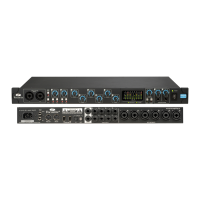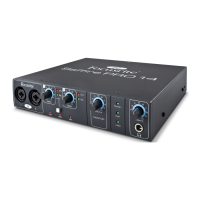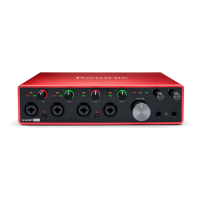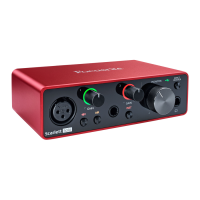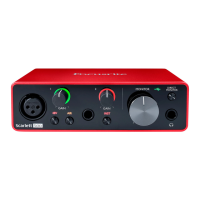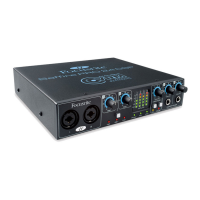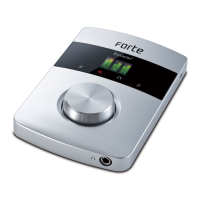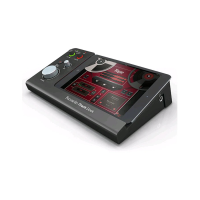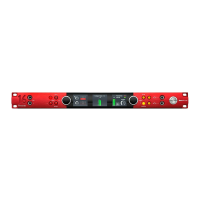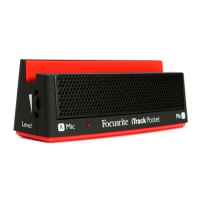Do you have a question about the Focusrite Saffire Pro 24 and is the answer not in the manual?
Lists items included with the Saffire PRO 24 DSP hardware.
Explains how to connect the Saffire PRO 24 DSP via FireWire and related considerations.
Details the input and output connections on the rear of the Saffire PRO 24 DSP.
Describes the input connectors, gain controls, monitoring controls, and indicators on the front panel.
Lists the minimum OS, computer, CPU, memory, and screen resolution requirements.
Provides step-by-step instructions for installing the Saffire PRO 24 DSP software on Windows.
Provides step-by-step instructions for installing the Saffire PRO 24 DSP software on Mac OS.
Illustrates audio signal paths using ADAT and S/PDIF at 44.1kHz/48kHz sample rates.
Illustrates audio signal paths using ADAT and S/PDIF at 88.2kHz/96kHz sample rates.
Details the different sections and controls of the Saffire MixControl software interface.
Explains how to select Line or Inst for combi inputs and adjust gain.
Explains the functionality and purpose of the mixer section for monitoring.
Describes how to select mixer tabs and configure input channels within the mixer.
Details how to select audio sources for mixer channels.
Explains the functions of Pan Slider, Fader, Meter, Mute, Solo, and PFL controls.
Explains stereo linking and configuring output channels for mixes.
Details the functionality and controls of the compressor effect.
Explains the functionality and controls of the equalizer effect.
Describes FX Chain Order, Mono/Stereo FX, and Input/Output Meters.
Explains how to monitor inputs with or without DSP effects.
Explains how to record signals with or without applying DSP effects.
Details the controls for adjusting the reverb effect (Size, Pre-Filter, Air).
Explains how to set the reverb return levels for each mix.
Explains how to assign audio sources to physical outputs.
Provides notes on headphone routing and ADAT channel behaviour at different sample rates.
Describes available presets for quick routing setup (Clear, DAW Tracking, Zero Latency, Mixing, Loopback).
Explains how VRM simulates speaker and room acoustics for headphone monitoring.
Lists available listening environments, speaker models, and listening positions.
Provides dimensional, reverb time, and loudspeaker emulation data.
Explains how to use the VRM interface to select environments, positions, and speakers.
Details VRM information display and application to headphone/line outputs.
Explains the function and states of monitor control enable buttons (Blue, Red, Grey).
Describes the software monitor knob and dim control for adjusting output levels.
Lists and explains available presets for monitoring setups (Stereo, Quad, Surround, etc.).
Illustrates speaker connections for surround and main monitoring setups.
Provides detailed descriptions of each monitor preset option.
Details Dim, Mute, Left Mute, and Right Mute switches.
Explains how to view and change sample rate and sync source settings.
Describes the FireWire driver connection status and unit naming.
Explains how to configure the optical input for ADAT or S/PDIF use, and SPDIF AC3.
Details how to adjust Firewire driver latency to improve performance.
Explains the option to disable WDM audio for exclusive DAW use in Windows.
Explains how to set the ASIO buffer size for latency and CPU management.
Details saving, loading, and resetting Saffire MixControl configurations.
Lists performance specifications for microphone, line, and instrument inputs.
Lists performance specs for analogue outputs and digital I/O.
Details the analogue and digital input/output connections.
Explains front panel indicators, other I/O like FireWire/MIDI, and dimensions.
Directs users to the online Answerbase for troubleshooting assistance.
Lists items included with the Saffire PRO 24 DSP hardware.
Explains how to connect the Saffire PRO 24 DSP via FireWire and related considerations.
Details the input and output connections on the rear of the Saffire PRO 24 DSP.
Describes the input connectors, gain controls, monitoring controls, and indicators on the front panel.
Lists the minimum OS, computer, CPU, memory, and screen resolution requirements.
Provides step-by-step instructions for installing the Saffire PRO 24 DSP software on Windows.
Provides step-by-step instructions for installing the Saffire PRO 24 DSP software on Mac OS.
Illustrates audio signal paths using ADAT and S/PDIF at 44.1kHz/48kHz sample rates.
Illustrates audio signal paths using ADAT and S/PDIF at 88.2kHz/96kHz sample rates.
Details the different sections and controls of the Saffire MixControl software interface.
Explains how to select Line or Inst for combi inputs and adjust gain.
Explains the functionality and purpose of the mixer section for monitoring.
Describes how to select mixer tabs and configure input channels within the mixer.
Details how to select audio sources for mixer channels.
Explains the functions of Pan Slider, Fader, Meter, Mute, Solo, and PFL controls.
Explains stereo linking and configuring output channels for mixes.
Details the functionality and controls of the compressor effect.
Explains the functionality and controls of the equalizer effect.
Describes FX Chain Order, Mono/Stereo FX, and Input/Output Meters.
Explains how to monitor inputs with or without DSP effects.
Explains how to record signals with or without applying DSP effects.
Details the controls for adjusting the reverb effect (Size, Pre-Filter, Air).
Explains how to set the reverb return levels for each mix.
Explains how to assign audio sources to physical outputs.
Provides notes on headphone routing and ADAT channel behaviour at different sample rates.
Describes available presets for quick routing setup (Clear, DAW Tracking, Zero Latency, Mixing, Loopback).
Explains how VRM simulates speaker and room acoustics for headphone monitoring.
Lists available listening environments, speaker models, and listening positions.
Provides dimensional, reverb time, and loudspeaker emulation data.
Explains how to use the VRM interface to select environments, positions, and speakers.
Details VRM information display and application to headphone/line outputs.
Explains the function and states of monitor control enable buttons (Blue, Red, Grey).
Describes the software monitor knob and dim control for adjusting output levels.
Lists and explains available presets for monitoring setups (Stereo, Quad, Surround, etc.).
Illustrates speaker connections for surround and main monitoring setups.
Provides detailed descriptions of each monitor preset option.
Details Dim, Mute, Left Mute, and Right Mute switches.
Explains how to view and change sample rate and sync source settings.
Describes the FireWire driver connection status and unit naming.
Explains how to configure the optical input for ADAT or S/PDIF use, and SPDIF AC3.
Details how to adjust Firewire driver latency to improve performance.
Explains the option to disable WDM audio for exclusive DAW use in Windows.
Explains how to set the ASIO buffer size for latency and CPU management.
Details saving, loading, and resetting Saffire MixControl configurations.
Lists performance specifications for microphone, line, and instrument inputs.
Lists performance specs for analogue outputs and digital I/O.
Details the analogue and digital input/output connections.
Explains front panel indicators, other I/O like FireWire/MIDI, and dimensions.
Directs users to the online Answerbase for troubleshooting assistance.
| Converter Bit Depth | 24-bit |
|---|---|
| Analog Inputs | 4 |
| Computer Connectivity | FireWire |
| MIDI I/O | Yes |
| Phantom Power | Yes |
| Sample Rate | 96 kHz |
| Digital Inputs | S/PDIF |
| Digital Outputs | S/PDIF |
| FireWire Ports | 2 |
| Software Included | Saffire MixControl |
| Analog Outputs | 6 |
